
Search Wild Foods Home Garden & Nature's Restaurant Websites:
Mulberries
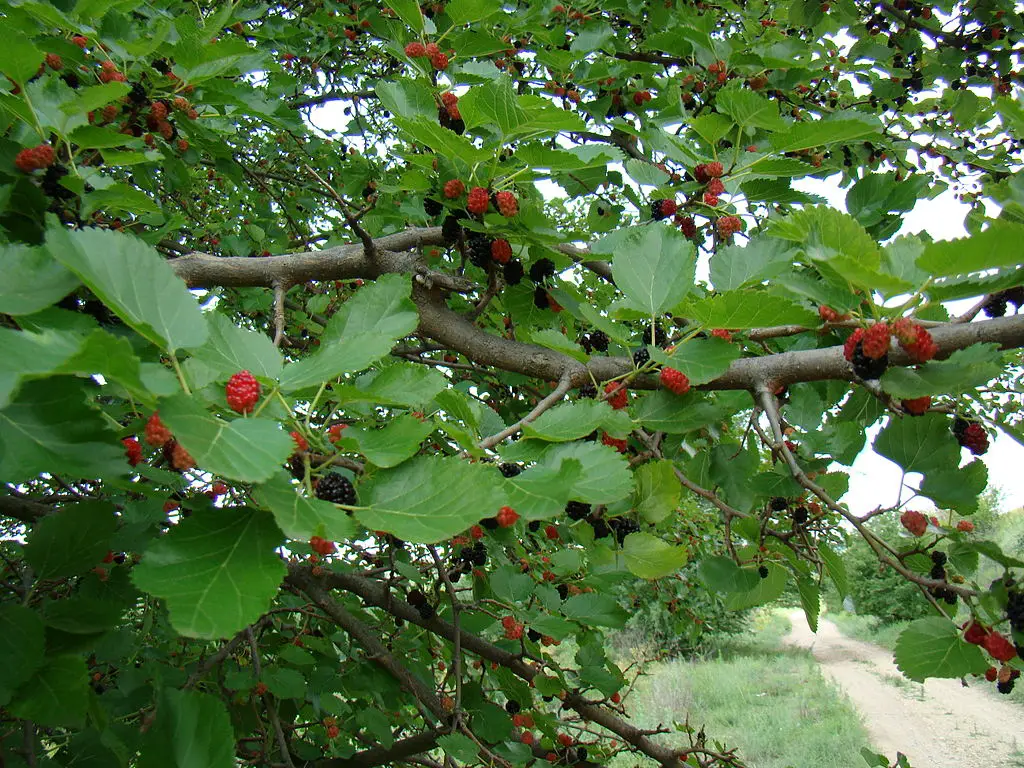
Black Mulberry (Morus nigra). (By: Yuriy75 CC BY-SA 3.0)
(NOTE: If you are not interested in growing the Mulberry tree, but just finding the fruit and using it, try going to the Nature's Restaurant Online site for Mulberries.)
Mulberries: Red Mulberry (Morus rubra) (native to North America), the White Mulberry (Morus alba) (native to Asia, but now naturalized in North America) and the Black Mulberry (Morus nigra) - also not native to North America - which is occasionally found as a tree planted for its fruit, although not known to have naturalized in North America like it has in Europe. The Mulberry is a great wild, and often city found berry. Along fence lines, in parks, backyards, fields let go wild, roadsides, well, almost everywhere in the Carolinian zone (eastern deciduous forest or eastern woodlands). They look a lot like a Raspberry or Blackberry, but the taste is unique. They tend to become ripe in July, and they let you know when they are ripe by turning a dark red/purple color. When not ready, they are first greenish or whitish, then pinkish.
Mulberries contain relatively high amounts of the nutrient resveratrol.
If you buy at a nursery, you can usually get the Red or Black Mulberry and either one is a good choice. If you want to grow from seed, make sure the fruit is tasty before you use the seeds. But even then, if you have a Red Mulberry, it could have cross pollinated with a White Mulberry and the resulting tree would have dull tasting, but still quite edible fruit. If you can pay the money, this is a case where being sure you get the Red or Black is worth the cost. If not sure if you want a Red or Black one, talk to the nursery regarding what is best for where you live, but keep in mind the Red is native and the Black is not.
Seeds: They are very slow to get to fruit producing size from seed. The seeds do need to be stratified first. You first need to wash all the flesh off the seeds. Next, you need to put them in damp peat moss and put in a fridge for 2-3 months. Then, take out and plant very shallowly in potting soil in pots, keep moist by misting, or covering with plastic until they sprout. They sprout faster in a warm area. When sprouted, put in bright light, but not direct sun and keep the soil moist. When all danger of frost has passed, transplant to their new home, and protect from direct sun, slowly getting them used to morning and evening sun over time. By the second year in their permanent spot, they should be fine on their own except water if the soil starts to dry out.
Cuttings: Though you can propagate from cuttings and by layering yourself, both the Red and Black Mulberry require a lot of patience and experience. The only one that takes easily is the White Mulberry. I suggest buying a tree in this case.
Soil & Site: They can handle a little shading, but for fruit production, you will need a sunny spot. They can grow in a wide range of soil pH and soil types.
Maintenance: There really is nothing you need to do after planting. Mulching at little under the tree helps keep the soil from drying out, but don't build a pile of mulch at the base of the tree.
Harvesting: You know they are ripe as they turn a dark red to purplish black. You also know, as there often many of them on the ground. If they are green, white or pink - they are not ripe. Also, they are very soft, almost mushy when ripe, while they are hard when unripe. To harvest, just pick ripe ones by hand. If you want a big harvest, put cotton sheets or plastic under the branches, and shake the tree. I used to climb the tree, but now when I do it I just use a long pole, push it under a branch and push up quickly. If they are ripe, it will rain Mulberries.
Using: They make great fresh eating right off the tree, pick them and keep in the fridge for a day or two, or cooked into baked goods – a really good all around berry. If they are frozen, when thawed they are quite mushy, but still good for baked items. The Red and Black Mulberry fruit is very tasty, while the White Mulberry is similar, but not as good - the flavor is duller. It is hard to tell if you have a Black or Red Mulberry unless you are looking for the differences, but they taste more or less the same, so really it doesn't matter. It is getting very hard to tell if you have a Red or White Mulberry now, as the trees are interbreeding, and blending into each other. Bottom line, taste the berry and see what you think. The good news is, all are edible, and even the worst tasting of the White Mulberries is just dull and sweet.
Web Resources:
Mulberry recipe search on the web for Mulberries from any of the three types of Mulberry tree here (Google search) and here (Bing search).
Red Mulberry (Morus rubra):
You need to live in a climate zone 5 or higher. No problem in most of Eastern USA except for the upper colder states. Can do very well in the lower area of Southern Ontario. If you find one in the wild, you can use layering to propagate it, or if you find the Mulberries, it will readily take from seed - but you have to stratify them first. Make sure you taste the berries first, as this tree has been hybridizing with the White Mulberry and some of them produce fruit that tastes like the flavor has been drained out. If you find a really flavorful, tasty Mulberry, save some seeds and plant and hope they are not cross pollinated with the White Mulberry.
Description:
- USDA Plant Hardiness Zone: 5-9 (More information on hardiness zones).
- Soil pH: 5.0-7.5
- Plant Size: Up to 20 meters (65 feet) tall, but usually shorter, in open areas tends to grow shorter and wide - a fast growing tree when young
- Duration: Lives up to around 125 years old
- Leaf Shape: Heart shaped, when tree is young, some leaves have deep lobes (usually asymmetrical), when older there are fewer lobed leaves. Can have one deep lobe near stem end of leaf giving a mitten shape to the leaf
- Leaf Phyllotaxis (Arrangement) on branch: Alternate
- Leaf Size: 7-14 cm (2 3/4 to 5 1/2 inches) long and 6-12 cm (2 1/3 to 4 3/4 inches) wide
- Leaf Margin: finely Serrated (saw toothed edge)
- Leaf Notes: A rough, scratchy, hairy texture on the upper side of the leaf, and soft hairy texture on the underside. Normally this feature can be used to distinguish from the White Mulberry, but since they are hybridizing, this feature is not as reliable
- Flowers: Catkins of tiny flowers. Male flowers are light yellow on a green catkin. Female flowers are white on green catkins.
- Fruit: Looks like a Blackberry or Raspberry. First green, then red (Raspberry color), then a dark purple (Blackberry color). 2-3 cm (4/5 to 1 1/5 inches) long. If a pure Red Mulberry - the taste is rich and sweet, if a hybrid with the White Mulberry, the taste can vary from good to dull.
- Bark: Twigs: reddish brown. Small trunks and branches: reddish brown. Main trunk on mature tree: Grey, broken in to vertical sections, or plates, with reddish tint to areas inside fissures.
- Habitat: Zone 5 or warmer, well drained rich soils. Can tolerate a range of conditions, prefers full sun, but will survive some shading, from slightly acidic to moderately alkaline soils - seems to do best where slightly alkaline.
Web Resources:
- Pictures of the tree on the web here (Google images) and here (Bing images).
- Pictures of the berries on the web here (Google images) and here (Bing images).
- Interactive USDA distribution map and plant profile here.
- The Biota of North America Program (BONAP) distribution map here. BONAP map color key here.
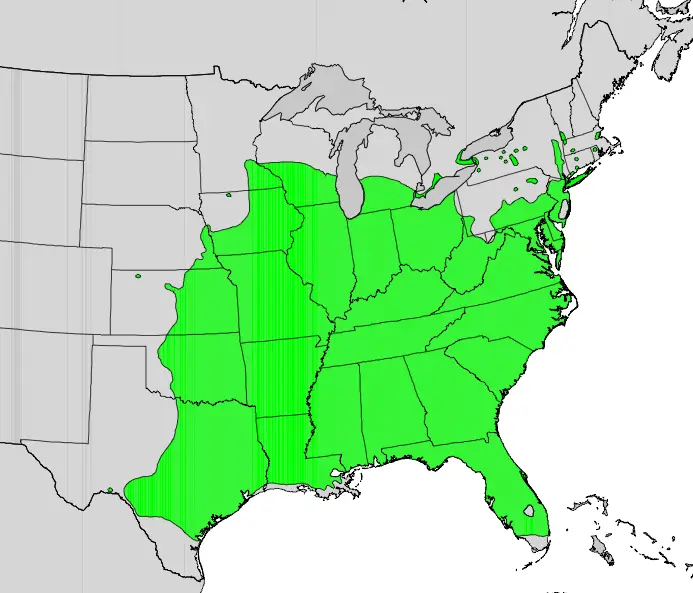
Red Mulberry (Morus rubra) range. Distribution map courtesy of the USGS Geosciences and Environmental Change Science Center, originally from "Atlas of United States Trees" by Elbert L. Little, Jr. .
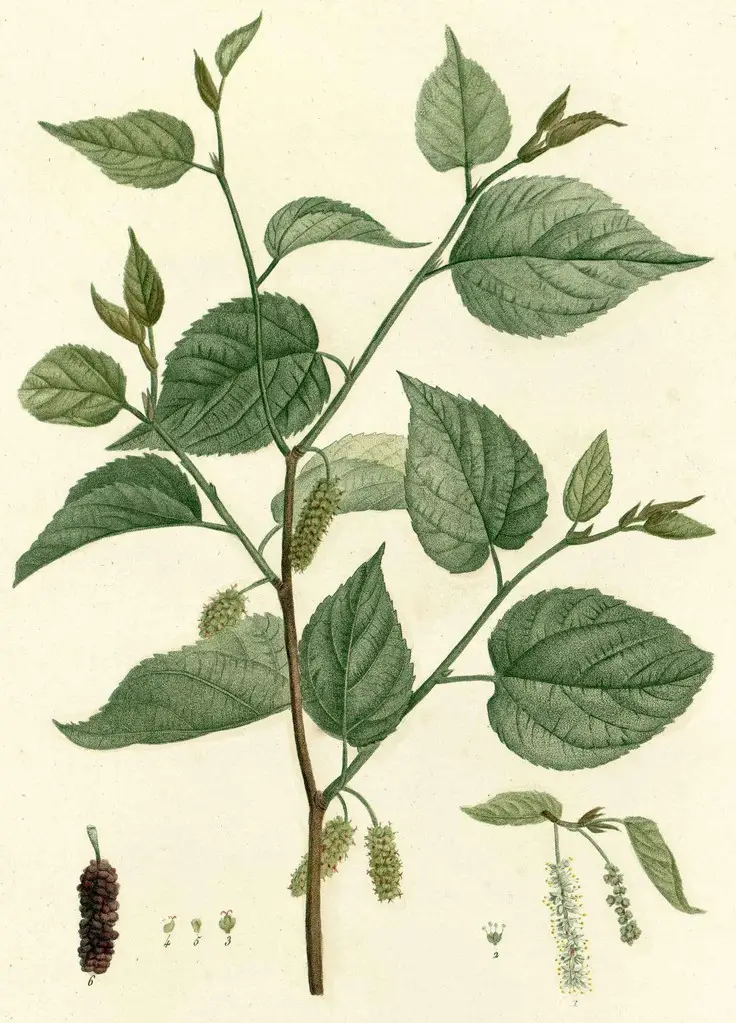
Red Mulberry (Morus rubra) illustration. (By: Duhamel du Monceau, H.L., Traité des arbres et arbustes, Nouvelle édition [Nouveau Duhamel], vol. 4: t. 23 (1809) [P.J. Redouté] drawing: P.J. Redouté)
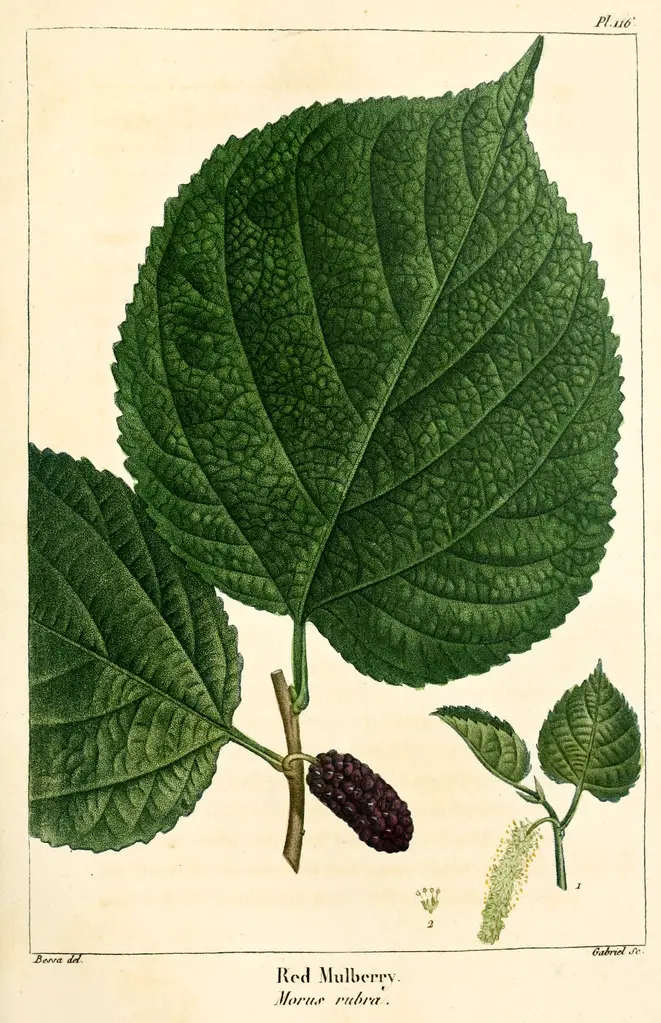
Red Mulberry (Morus rubra) illustration. (By: François André Michaux)
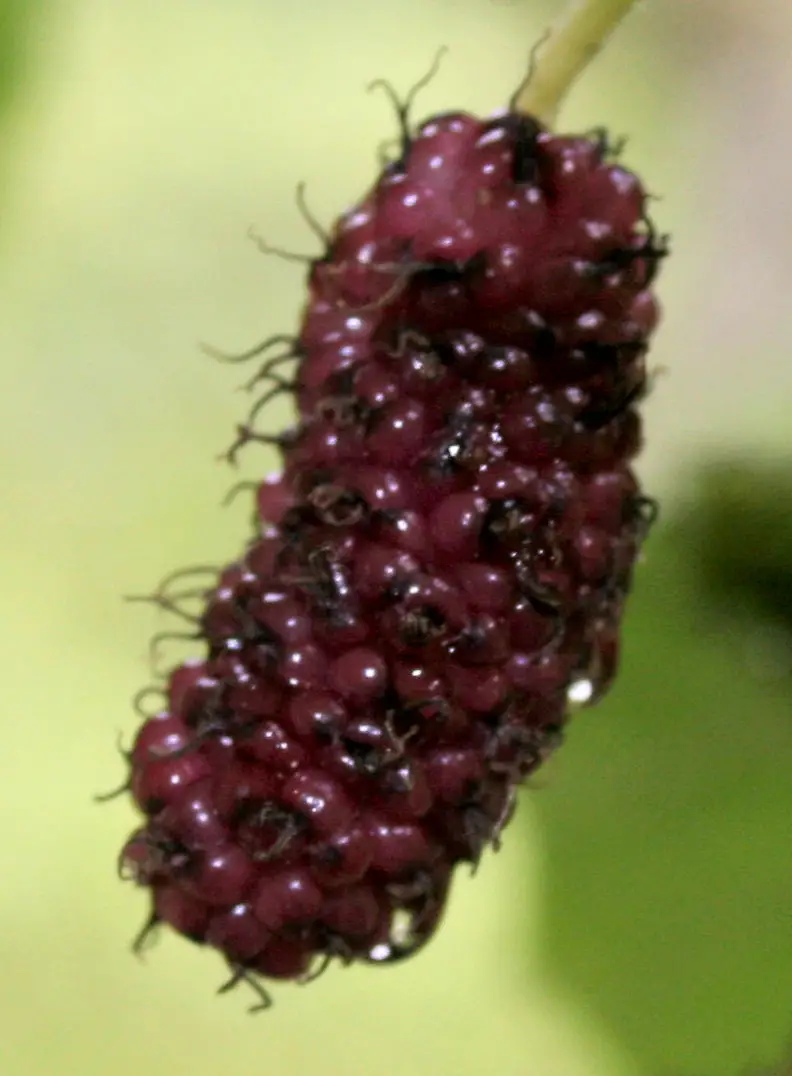
Red Mulberry (Morus rubra) fruit. (By: LeonAdler CC BY-SA 3.0)
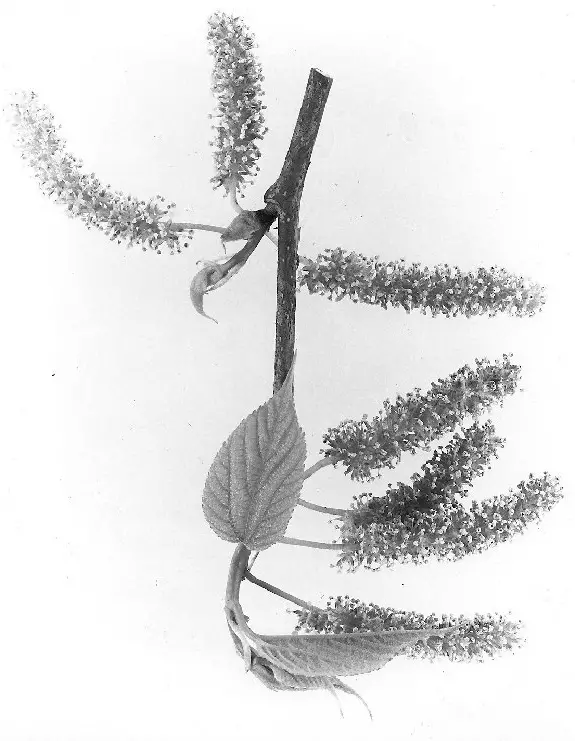
Red Mulberry (Morus rubra) male tree twig, leaves and flowers. (USDA-NRCS PLANTS Database)
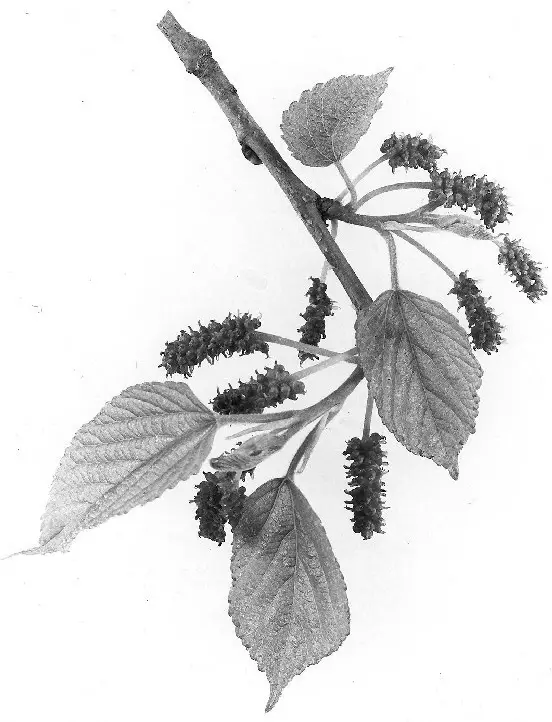
Red Mulberry (Morus rubra) female tree twig, leaves and flowers/immature fruit. (USDA-NRCS PLANTS Database)
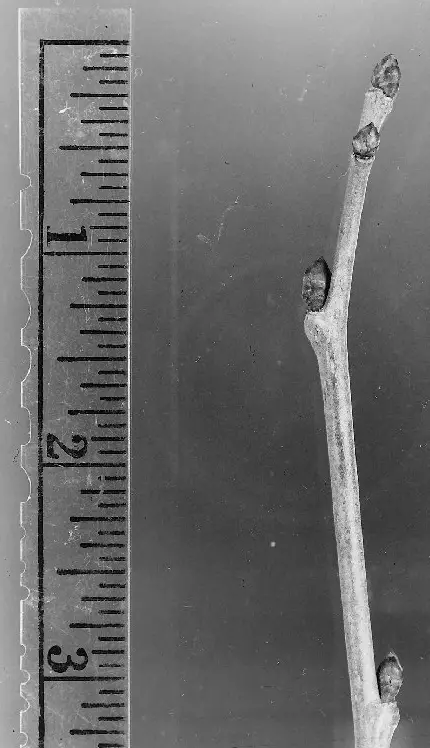
Red Mulberry (Morus rubra) twig and buds. (W.D. Brush, hosted by the USDA-NRCS PLANTS Database)
White Mulberry (Morus alba). Not native to North America (originally from China) but now a very common naturalized tree in Eastern North America to the point it is being labelled an invasive species in many areas. Hybridizes with the Red Mulberry, so sometimes it is very hard to tell what tree you have.
Though a perfectly safe berry to eat, it is least tasty of the three. It is sweet, but there is a dull lack of balancing tartness and less flavor. Hybrids with the Red Mulberry can be anywhere in between in taste. Although most have berries that are red, there are cultivars that have off-white and pink ripe fruit. The easiest way to tell if you have one of these is by the shiny, smooth upper leaf surface (dull and scratchy on the other two) and the taste of the fruit. Really though, if you like the taste of the fruit from a tree, it doesn't matter which one you have. Where I live in Southwestern Ontario, there are more hybrids now than either the Red or White Mulberry, and you just have to taste the berry before deciding whether to harvest more.
Though this is not an herbal book, I have to say there are lots of positive claims for the young leaves when made into tea. It is claimed they help regulate blood sugar (regardless of cause), block absorption of carbohydrates thus helping with weight control, plus it is claimed the tea helps with cognition, memory formation and reduces plaque in the arteries. So what the berries lack in flavor, the leaves apparently make up for.
I'd suggest not growing this one. First, the fruit is not nearly as good tasting as either the Red or Black Mulberry. Second, it is listed as an invasive species in many parts of Eastern North America. Third, it is hybridizing with the Red Mulberry, and the resulting hybrids have berries that are generally not as good tasting as the Red Mulberry. Stick to either the Red or Black Mulberry if you are going to plant a tree or start from seed for the fruit. If you want the leaves for tea, that's a different story.
Description:
- USDA Plant Hardiness Zone: 4-9 (More information on hardiness zones).
- Soil pH: 6.0-7.5
- Plant Size: Up to 20 meters (65 feet) tall.
- Duration: Can live many decades
- Leaf Shape: Ovate to heart shaped, with or without lobes. Generally, on smaller trees many of the leaves have irregular lobes, on more mature trees there are fewer leaves with lobes.
- Leaf Phyllotaxis (Arrangement) on branch: Alternate
- Leaf Size: Very young trees: up to 30 cm (12 inches) long with many deep rounded lobes. Mature trees: up to 15 cm (6 inches) long, fewer leaves have lobes
- Leaf Margin: finely Serrated (saw toothed edge)
- Leaf Notes: Lobing is highly variable, not as rough or dark colored on the leaf upper surface as the other two Mulberry trees. Upper leaf surface is glossy. Seedlings have larger leaves with a yellow hue.
- Flowers: Catkins of tiny flowers. Male flowers are light yellow on a green catkin. Female flowers are white on green catkins.
- Fruit: 1-2.5 cm (2/5 to 1 inch) long. Dark Purple when ripe in most wild variants, however there are cultivars that have off-white and pink ripe fruit.
- Bark: Younger bark has an orange tint to it, becoming more grey as it gets older with some orange inside fissures. When young and the bark is smooth there are off-white horizontal lenticels (checking). When older, there are vertically oriented high ridges.
- Habitat: Highly adaptable to most any soil type except very acidic. Can tolerate wide range of moisture. Does better in full sun, but will survive shading except for very dark shade.
Web Resources:
- Pictures of the tree on the web here (Google images) and here (Bing images).
- Pictures of the berries on the web here (Google images) and here (Bing images).
- Interactive USDA distribution map and plant profile here.
- The Biota of North America Program (BONAP) distribution map here. BONAP map color key here.
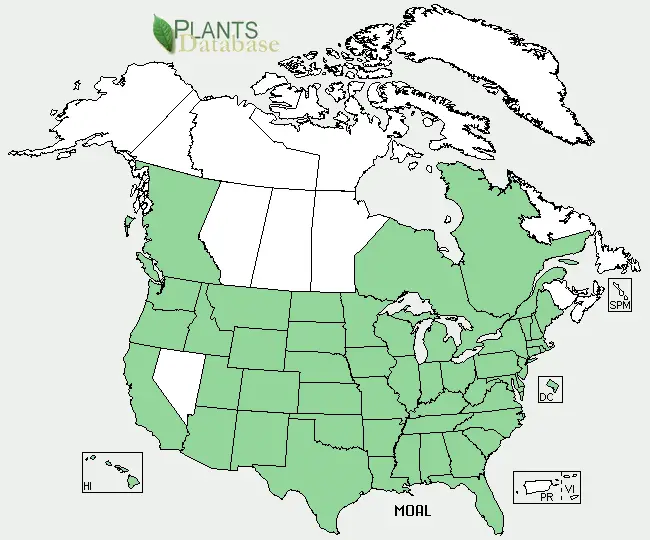
White Mulberry (Morus alba) range. Distribution map courtesy of U. S. Department of Agriculture (USDA Natural Resources Service) and used in accordance with their policies.
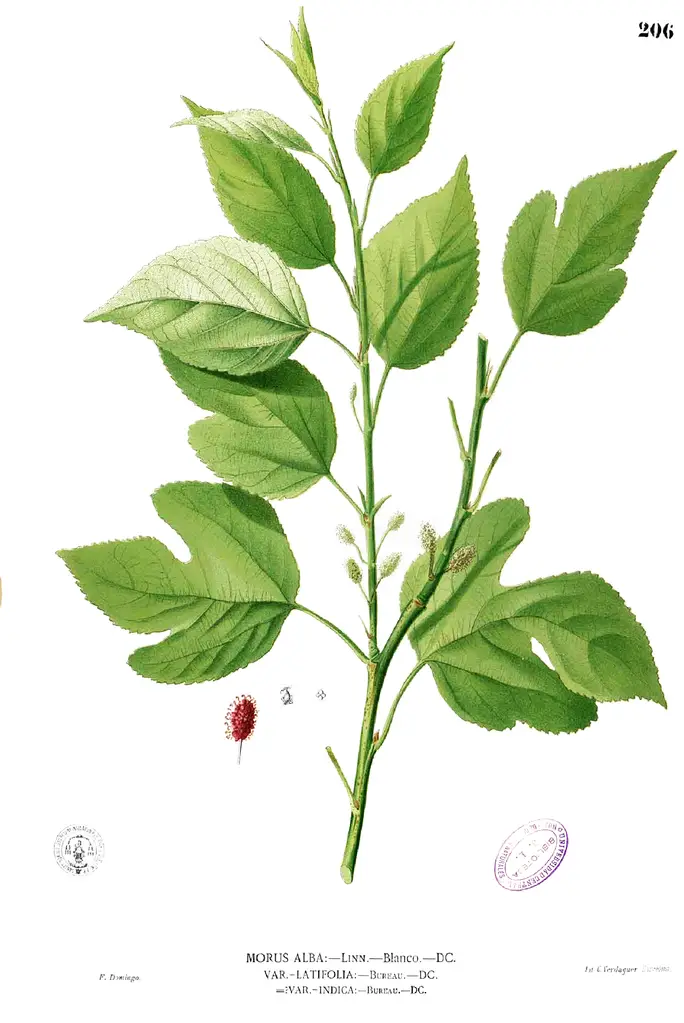
White Mulberry (Morus alba) illustration. (By: Francisco Manuel Blanco (O.S.A.) Flora de Filipinas)
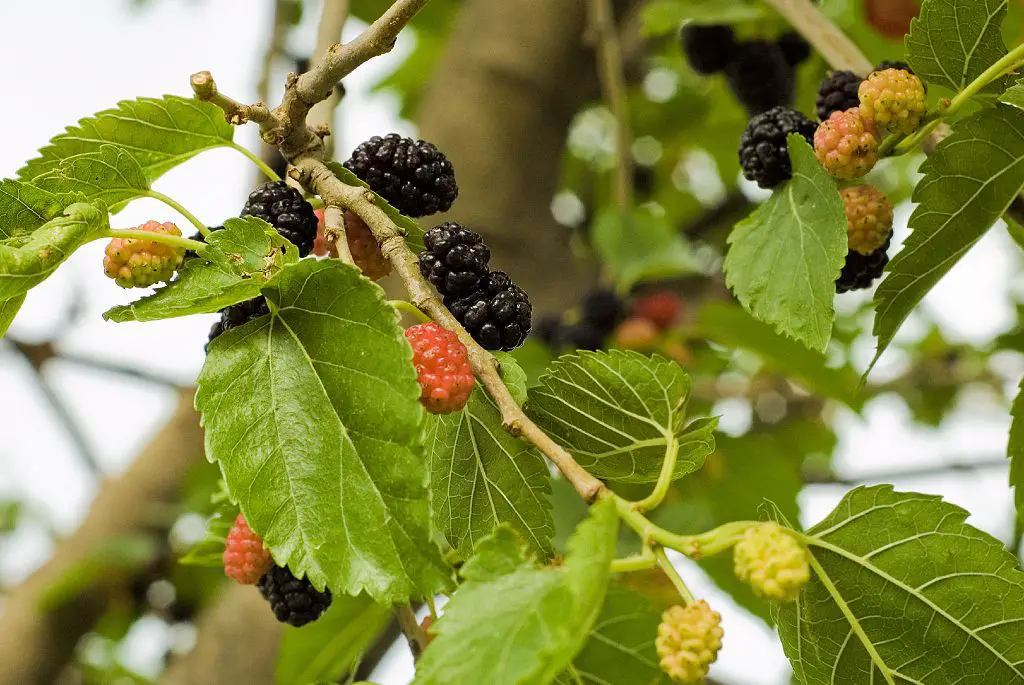
White Mulberry (Morus alba) leaves and fruit in stages from unripe to ripe. (By: Vladimer Shioshvili Attribution 2.0 Generic)
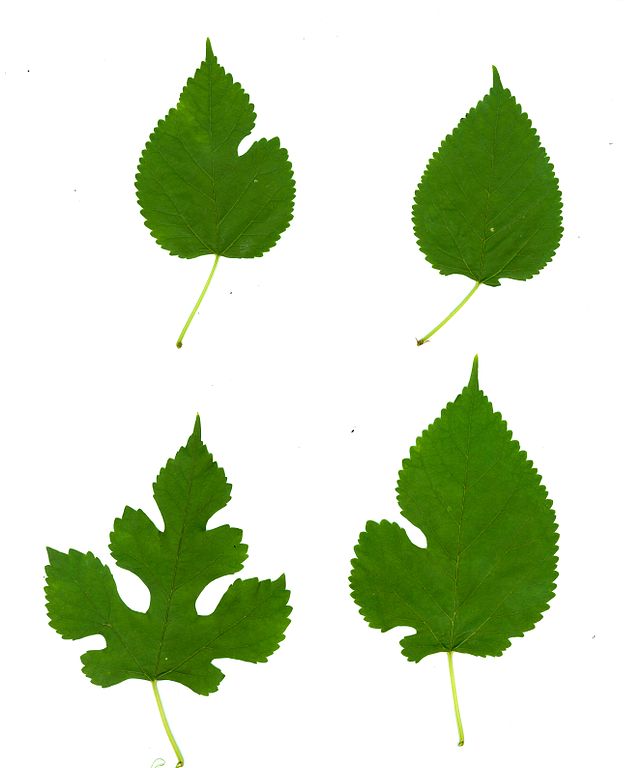
White Mulberry (Morus alba). The leaf can have widely varrying lobes. (By: Jaknouse CC BY-SA 3.0)
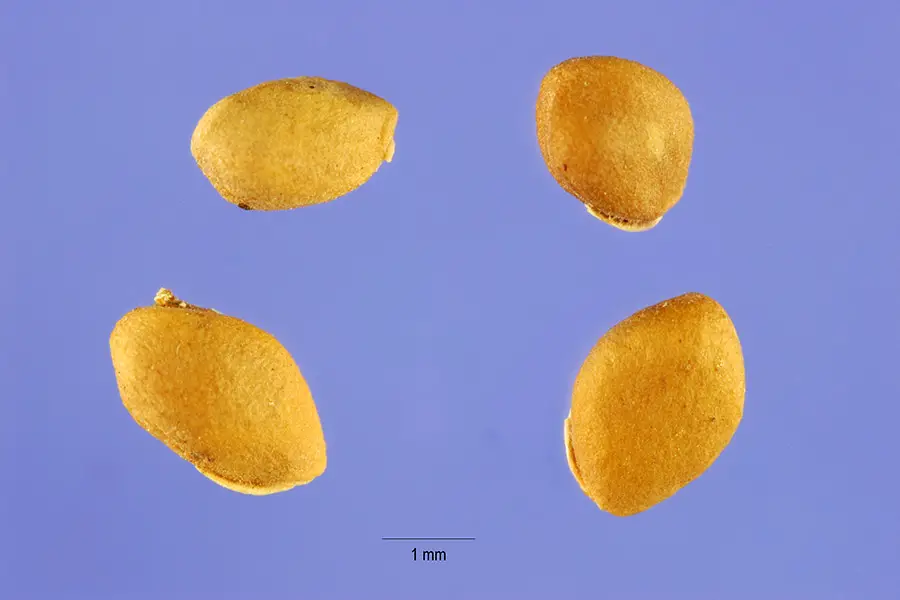
White Mulberry (Morus alba) seeds. (By: Steve Hurst, hosted by the USDA-NRCS PLANTS Database)
Black Mulberry (Morus nigra). I don't think I've ever had the fruit from this particular Mulberry, but from what I gather, the fruit tastes basically the same as the Red Mulberry. There are cultivars that have been bred to produce particular characteristics with the fruit, such as very long berries.
Growing this tree in your home garden:
Yes, if you live in the right climate zone - zone 5 and up, this is a good choice. There are cultivars of this tree that are selected for the qualities of the fruit that you can choose from. Though not native like the Red Mulberry, this one does not have the habit of naturalizing like the White Mulberry and becoming invasive.
Description:
- USDA Plant Hardiness Zone: 5-14 (More information on hardiness zones).
- Soil pH: 5.5-8.5
- Plant Size: Up to 12 meters (40 feet) tall.
- Duration: Moderately long lived tree
- Leaf Shape: Ovate to heart shaped.
- Leaf Phyllotaxis (Arrangement) on branch: Alternate
- Leaf Size: 10–20 cm (4 to 8 inches) long by 6–10 cm (2 to 4 inches) wide, though can be bigger on fast growing seedling
- Leaf Margin: Serrated (saw toothed edge)
- Leaf Notes: This Mulberry has leaves that are rarely lobed, soft and hairy on underside, rough and hairy on upper side of leaf
- Flowers: Catkins of tiny flowers. Male flowers are light yellow on a green catkin. Female flowers are white on green catkins.
- Fruit: Tasty, variable in length. Green and orange at first, then orange-red, and finally dark purple/black when ripe
- Bark: Grey on mature trunks, with irregular vertical ridging
- Habitat: Zone 5-11. Withstands most conditions except extremes in Eastern North America.
Web Resources:
- Pictures on the web here (Google images) and here (Bing images).
- Interactive USDA distribution map and plant profile here.
- The Biota of North America Program (BONAP) distribution map here. BONAP map color key here.
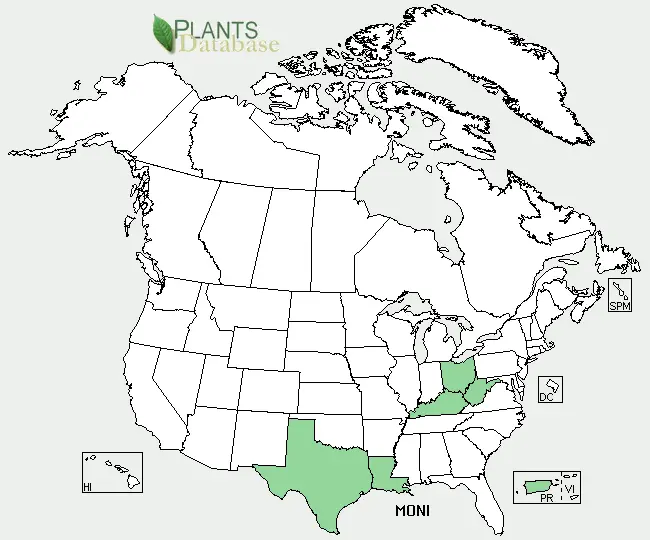
Black Mulberry (Morus nigra) range. Distribution map courtesy of U. S. Department of Agriculture (USDA Natural Resources Service) and used in accordance with their policies
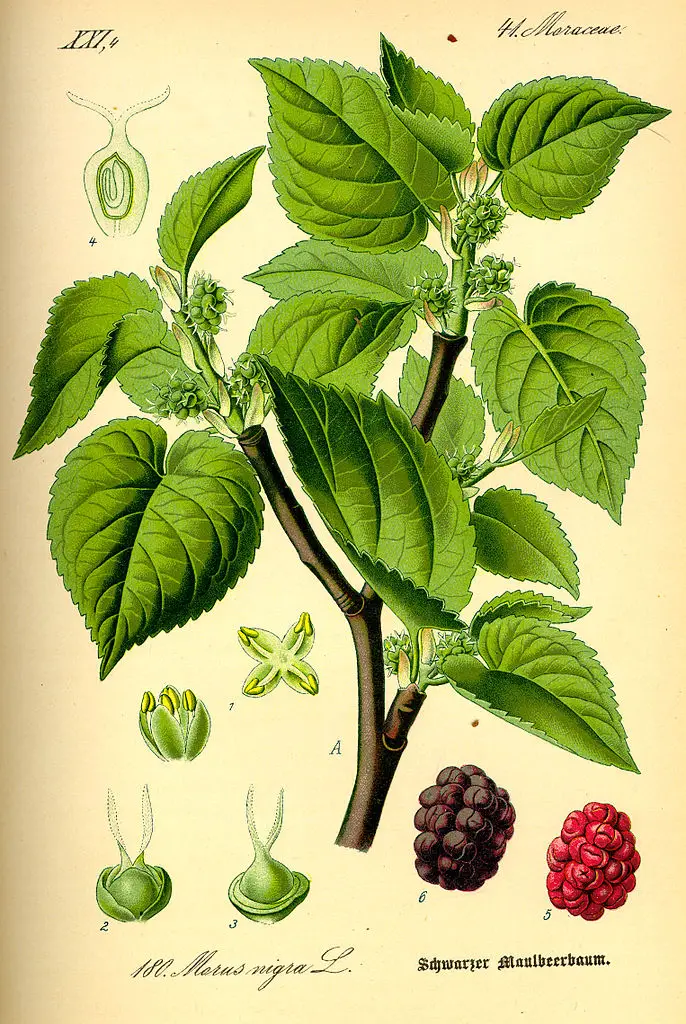
Black Mulberry (Morus nigra) (By: Prof. Dr. Otto Wilhelm Thomé Flora von Deutschland, Österreich und der Schweiz 1885, Gera, Germany)
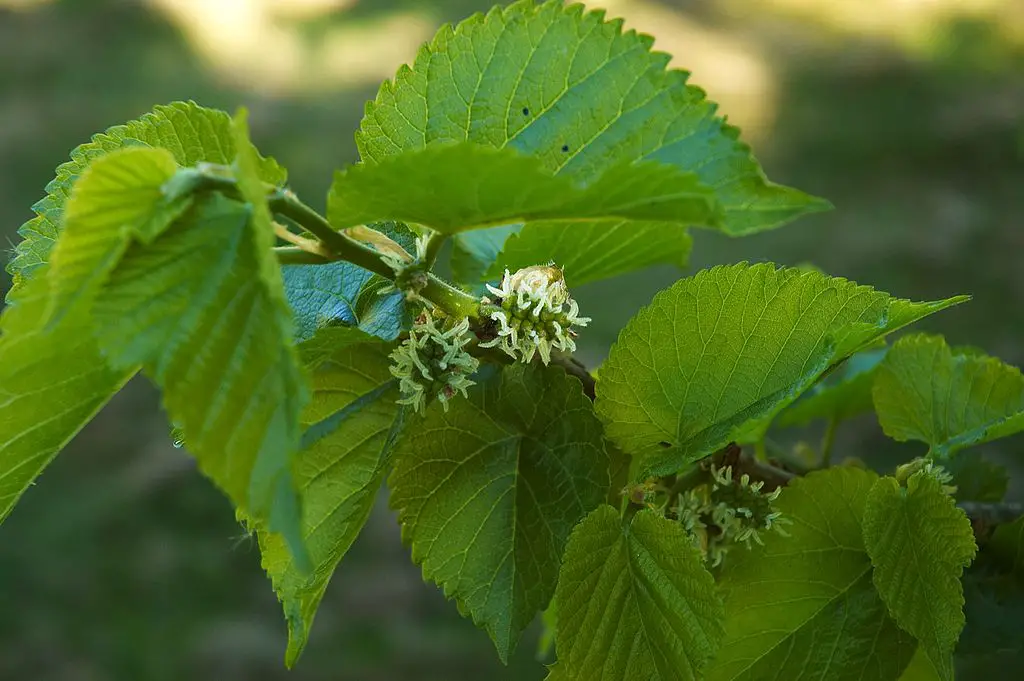
Black Mulberry (Morus nigra) female tree in flower. (By: Wouter Hagens)
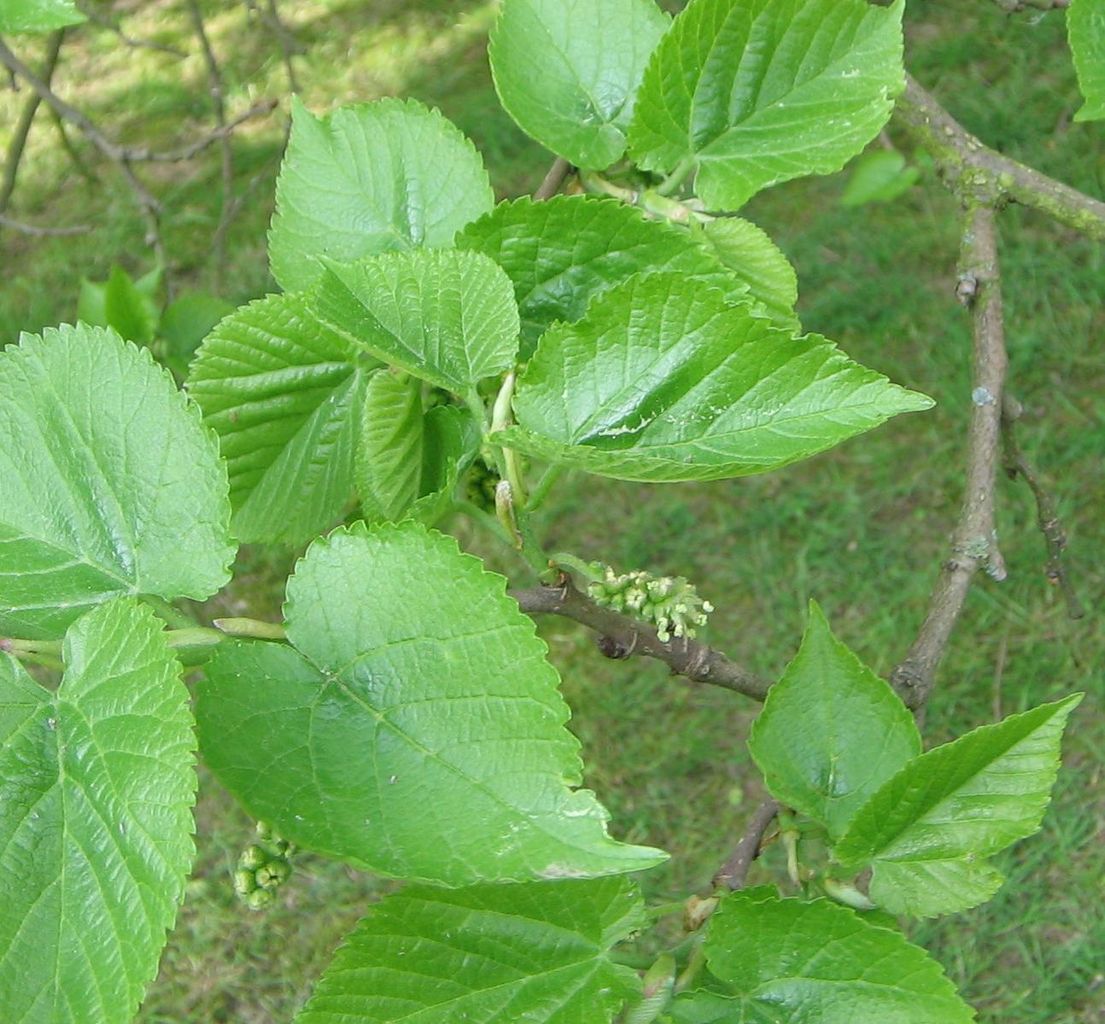
Black Mulberry (Morus nigra) male tree with flowers just starting to come out of bud. (By: Meneerke bloem GNU Free Documentation License, Version 1.2)
Black Mulberry (Morus nigra) in fruit. Fruit in various stages. Only the black fruit is ripe. (By: Haplochromis GNU Free Documentation License, Version 1.2)
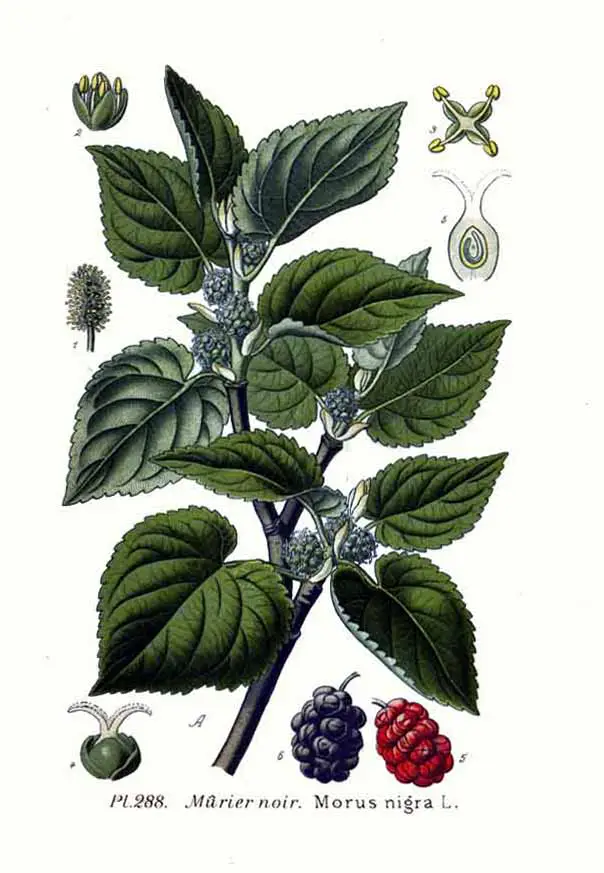
Black Mulberry (Morus nigra) illustration. (By: Amédée Masclef)
Search Wild Foods Home Garden & Nature's Restaurant Websites:
Share:
Why does this site have ads?
Originally the content in this site was a book that was sold through Amazon worldwide. However, I wanted the information to available to everyone free of charge, so I made this website. The ads on the site help cover the cost of maintaining the site and keeping it available.
Google + profile
